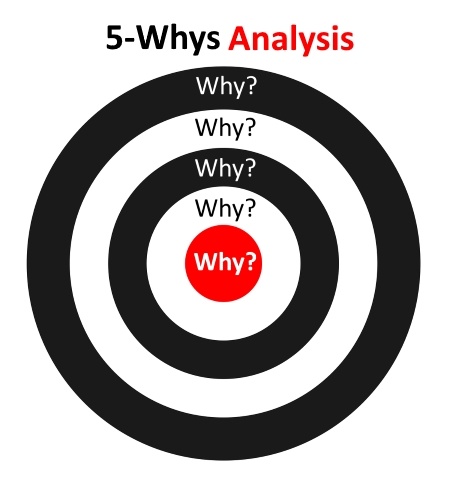We all experience daily frustrations and problems in the operation of our business. However, the underlying causes are not always apparent. The Toyota Motor Company encourages managers to go to the faulty business process and watch it in action. Mistakes, errors, and waste are often uncovered using simple observation and logic. The Toyota Production System also applies another technique called the “5-Whys Analysis” to quickly drill-down to the root cause of operational problems.

5-Whys Analysis
Although a simple method, the 5-Whys Analysis can be very effective, especially when your problems involve human factors and interaction. By repeatedly asking the question, “Why—what caused this problem,” your thinking quickly peels away layers of symptoms and guides you to the true source of your trouble.
The origin of your problem will often be surprising and unexpected. You may uncover it in some other process or department. It may even be out of your control to fix. By the time you drill-down to the fourth or fifth “why,” you will likely be looking squarely at your management practices.
How to Perform a 5-Whys Analysis
To complete a 5-Whys Analysis, follow the three easy steps below:
- Write down your specific business problem clearly and completely. A good statement of the problem often points to its own solution.
- Ask “why” the problem happens and write your answer.
- Continue asking “why” to the previous answer until you or others agree that the problem’s root cause has been identified. (You may ask “why” fewer or more than five times.)
Let’s look at this real example from a photo-frame manufacturer to see how the 5-Whys Analysis revealed an unexpected root cause.
| Problem: Too many photo-frames are returned by customers for a refund. |
| Question 1: Why are the photo-frames returned? Answer: Because the paint finish on the frame is sometimes scratched. |
| Question 2: Why are so many frames scratched? Answer: Because some painted frames, after drying, are stored on pallets without any protection between layers. |
| Question 3: Why are frames stored without protective layers? Answer: Because the paint department sometimes runs out of the protective cardboard sheets. |
| Question 4: Why does the paint department run out of cardboard sheets? Answer: Because the cardboard stock isn’t always ordered on time. |
| Question 5: Why isn’t the cardboard ordered on time? Answer: Because the purchasing person is overloaded, and the cardboard is not a high priority. |
Ask Good Questions
If you know how to ask good, successive “why” questions, and are able to ask them of the right people, you will find at least one root cause for a given problem. This approach takes very little time to perform—five minutes—and does not require the use of special analysis tools. When your people become familiar with the 5-Whys exercise, it can be a fast and easy way to get at the source of daily problems.
Caution: Don’t stop asking “why” until you are satisfied that there is no deeper cause worth pursuing. By stopping the questions too early, you will identify intermediate causes that may address the problem but not solve it completely and permanently. Keep in mind that this approach generally leads to one root cause. If a “why” question leads to more than one answer, go down each path to uncover multiple root causes. Be careful not to let the 5-Whys method lead to an atmosphere of blaming people. Remember, your faulty systems or processes are usually to blame, not your people.
Go try the 5-Whys Analysis today on one of your persistent business problems. It is another weapon in the arsenal of the Systems Thinker.







